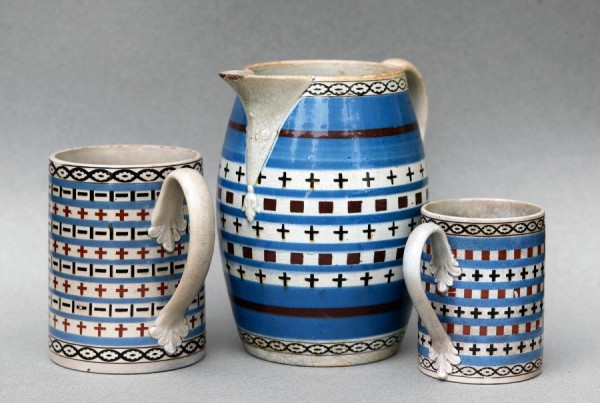
(Left to right) One-pint mug, one-quart jug, and half-pint mug, Wood & Caldwell, Burslem, Staffordshire, England, 1795–1805. Engine-turned pearlware. H. of mug on left 5". (Unless otherwise noted, all objects and photos are courtesy of Jonathan Rickard.) These three vessels illustrate related slip-filled, engine-turned design elements and the same rouletted bands. The pint mug has a large and clear impressed mark. The jug retains a label from the antiques department of the Boston jewelry store Shreve, Crump & Lowe.
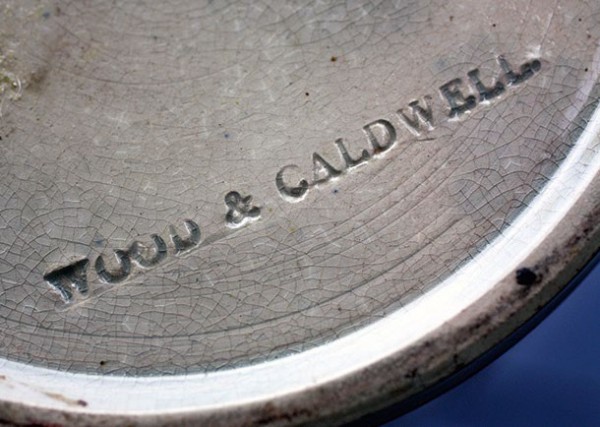
Detail of the impressed mark from the pint mug illustrated in fig. 1 at far left.

Details of the bottom handle rococo terminals from three related vessels, two of which are illustrated in fig. 1 (left and center).

Detail of the press-molded snip from the quart jug illustrated in fig. 1.

A key fragment from the Burslem waster pit placed on the quart jug illustrated in fig. 1.
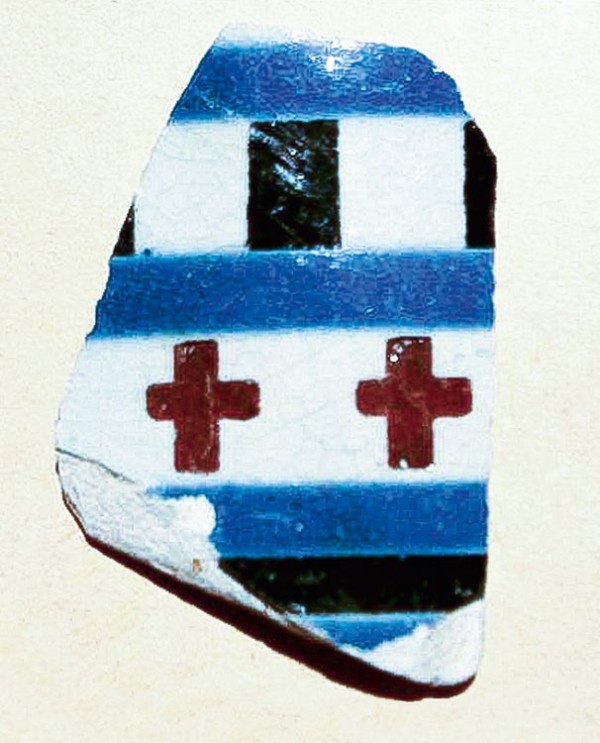
An excavated fragment from the site of the Bull’s Head Tavern in Baltimore, Maryland, that relates to the Wood & Caldwell vessels illustrated in fig. 1. (Courtesy, Patricia Samford, Archaeological Conservation Lab, Maryland Department of Planning.)

Punch bowl, attributed to Wood & Caldwell, Burslem, Staffordshire, England, 1795–1805. Engine-turned pearlware. D. 8 3/4". (Carpentier collection.) This punch bowl has lettering formed by impressing metal type characters into the leather-hard clay and filling the resulting depressions with black slip. The repetition of “GOD SAVE THE KING” likely was a toast given at gatherings during the illness of George III.

Detail of the multilevel engine-turned pattern illustrated in fig. 7.

Fragments from an archaeological investigation of the site of a warehouse at the Manchester Dock, Liverpool, England. (Photo courtesy of David Barker.) These examples, along with thousands of others, had been dumped as landfill during the remodeling of the dock between 1807 and 1808. The Staffordshire and other wares destined for export—most likely to the United States—seem to have been unsalable items discarded from one or more of the warehouses in the immediate vicinity of the dock. These fragments related directly to wasters found in Burslem and to archaeological examples in America.

Mug, attributed to Wood & Caldwell, Burslem, Staffordshire, England, 1795–1805. Engine-turned pearlware. H. 6". Leaning against this one-quart mug is a matching biscuit fragment from the Burslem site.

Excavated fragment from the Burslem site with a variation of the pattern on the surviving mug illustrated in fig. 10.

Comparison of the handle terminal from the surviving quart vessel illustrated in fig. 10 (left) and a biscuit waster (right). An advantage of the engine-turning process is the easy modification of mechanical elements to change the design of the turning. Here the subtle pattern change was accomplished by changing the rose cam on the engine-turning lathe.
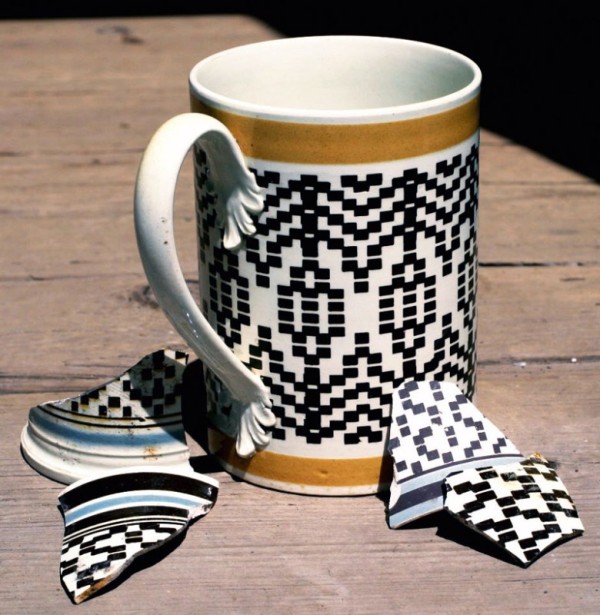
Mug, attributed to Wood & Caldwell, Burslem, Staffordshire, England, 1795–1805. Engine-turned pearlware. H. 6". This surviving one-quart mug with distinctive handle terminals is shown together with wasters from the Burslem dump site, typical of the bold slip-filled, engine-turned patterns of this group. One atypical waster has a lathe-turned molded foot.

Mug, attributed to Wood & Caldwell, Burslem, Staffordshire, England, 1795–1805. Engine-turned pearlware. H. 4 7/8". This one-pint mug was found in the pantry of a house in South Berwick, Maine, wrapped in 1937 newspaper together with a matching waster from the Burslem dump site. South Berwick borders the Piscataway River upstream from Portsmouth, New Hampshire.

Jug, possibly Wood & Caldwell, Burslem, Staffordshire, England, 1795–1805. Engine-turned pearlware. H. 8 3/4". (Colonial Williamsburg Art Museums.) This large, engine-turned jug has a history of ownership in the Long Island, New York, home of the American poet and editor William Jennings Bryan (1860–1925).

A fragmentary bowl excavated on the grounds of Strawbery Banke in Portsmouth, New Hampshire. (Courtesy, Strawbery Banke Museum.) The engine-turned pattern seen here nearly matches that on the jug illustrated in fig. 15, but is filled with colored slips rather than black. The bowl is nearly identical to the fragment illustrated in fig. 9 that was found in Liverpool.
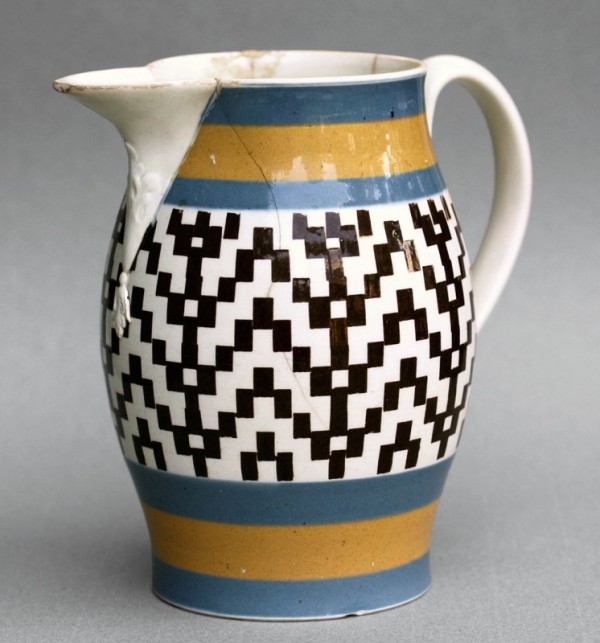
Jug, possibly Wood & Caldwell, Burslem, Staffordshire, England, 1795–1805. Engine-turned pearlware. H. 8 1/2".

Detail showing the distinctive press-molded snips with attached pendant on the jugs illustrated in figs. 15 and 17.

Detail of the handle terminals on the jugs illustrated in figs. 15 and 17.

Mug, attributed to Wood & Caldwell, Burslem, Staffordshire, England, 1795–1805. Engine-turned pearlware. H. 3 3/4".

Mug, attributed to Wood & Caldwell, Burslem, Staffordshire, England, 1795–1805. Engine-turned slip-decorated redware. H. 4 1/4". This mug with matching pattern and terminals is unusual in that it has a red earthenware body.

Mug, attributed to Wood & Caldwell, Burslem, Staffordshire, England, 1795–1805. Engine-turned pearlware. H. 4 1/4". This half-pint capacity mug has what seems to have been the most popular engine-turned pattern exported to North America.

Pitcher, probably Staffordshire, England, 1795–1805. Engine-turned pearlware. H. 7 3/4". (Collection of Shelburne Museum, gift of Edith C. Blum, 1976-74.27.)

Mug fragment, attributed to Wood & Caldwell, Burslem, Staffordshire, England, 1795–1805. Engine-turned pearlware. H. 4 1/4". This fragment is a waster from the Burslem site.

Mug, attributed to Wood & Caldwell, Burslem, Staffordshire, England, 1795–1805. Engine-turned pearlware. Dimensions not recorded. This quart-capacity mug has vertical engine-turned ribs between colored slip bands

Detail of the handle terminals on the ribbed surface of the mug illustrated in fig. 25.

A surviving one-pint mug with vertical engine-turned ribs similar to the example shown in fig. 25 and related Burslem ceramic wasters.

Mug, attributed Wood & Caldwell, Burslem, Staffordshire, England, 1795–1805. Engine-turned pearlware. H. 4 1/2". The frog figure attached to the inside of the mug might indicate why this mug has the exception of a protruding foot molding.
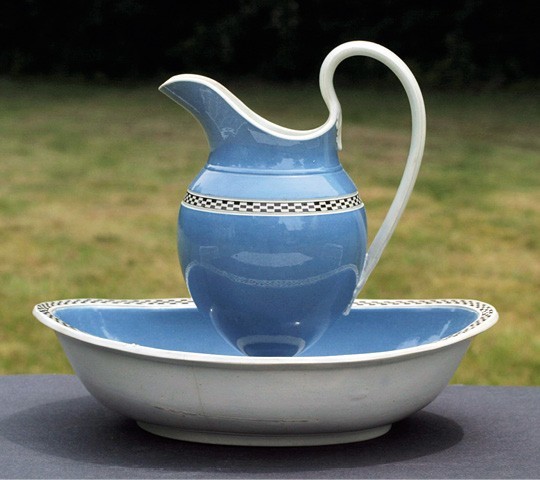
Basin and ewer, Staffordshire or Yorkshire, England, ca. 1795–1805. Engine-turned pearlware. Dimensions not recorded. This is likely the most heavily produced dipped-ware pattern made not only by Wood & Caldwell but by the Leeds Pottery in Yorkshire, not to mention Wood’s relative John Wood, who worked in Brownfield, Staffordshire, as well as other potters. While blue was by far the most popular color, these sets were produced with other ground colors as well. This ewer and basin is most unusual for its oval basin.

Handle terminal from the ewer illustrated in fig. 29.

A one-pint-capacity blue-dipped mug with related wasters from the Burslem site

A waster from the Burslem site related to the blue-dipped examples illustrated in figs. 29 and 31. It was a universal practice to clear a patch of wet slip in order to provide a secure seal when attaching the handle to a pot.

Dish and cover, attributed to Wood & Caldwell, Burslem, Staffordshire, England, 1795–1805. Engine-turned pearlware. Dimensions not recorded. This pearlware serving dish has a typical Wood & Caldwell acorn knop and was decorated with a veneer of colored-ware shavings from the engine-turning process.

An oval inlaid agate teapot shown with related Burslem biscuit wasters. The teapot is from the Carpentier collection at Eastfield Village.

A biscuit waster of inlaid agate pearlware from the Burslem site.

Bowl, attributed to Wood & Caldwell, Burslem, Staffordshire, England, 1795–1805. Pearlware. D. 7". A hemispherical bowl with mocha dendritic decoration and typical color bands touching without intervening space.

Mocha dendritic decoration biscuit wasters from the Burslem site.
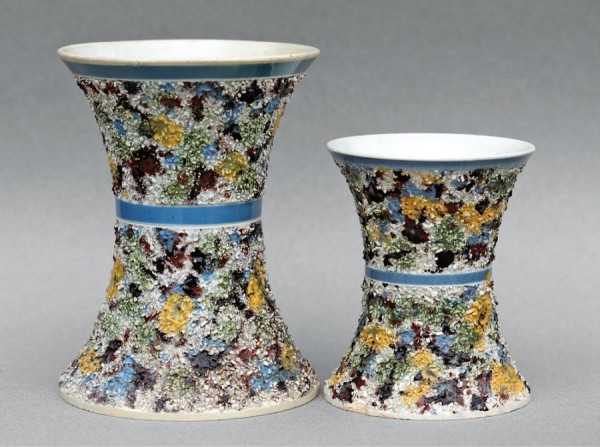
Spill vases, attributed to Wood & Caldwell, Burslem, Staffordshire, England, 1795–1805. Encrusted pearlware. H. 7". These vases might have been part of a garniture.

Glazed waster from the Burslem dump site. Note that the textured surface is made from white fragments adhered to the pot surface rather than shavings as seen in those illustrated in fig. 38.

Mug, attributed to Wood & Caldwell, Burslem, Staffordshire, England, 1795–1805. Pearlware. H. 5 7/8". This one-quart pearlware mug has a brown slip ground which is enameled with fioral decoration.

The enameled decoration of these fragments of biscuit wasters survived belowground for about two hundred and twenty years.

An assortment of pearlware glazed and biscuit fragments excavated by Don Carpentier from beneath the tarmac at the unused parking lot of the empty Doulton factory in Burslem, Staffordshire, in 2006.
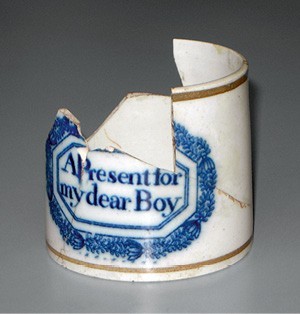
Mug, Burslem, Staffordshire, England, early nineteenth century. Engine-turned pearlware. Dimensions not recorded. This waster, recovered from the Burslem dump site, is from a transfer-printed child’s reward-of-merit mug.
